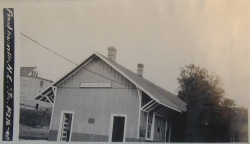Franklinville (milepost CR 16.2)
History
This town (altitude 469) in east Randolph County was named for Jesse Franklin, a Governor of NC (1760-1852). In the days of the A&Y, the town was on the Ramseur branch. In 1943, Franklinville trackage could hold 25 cars. The Morris Grist Mill was established there in 1801 and Elisha Coffin started a cotton mill there in 1838.
The Franklinville depot had a day telegraph station. In 1912 there was a spur siding (as can be seen on the track diagram below).
On the left is a partial photo of the station circa 1918 from the ICC Valuation engineers' reports. Click on the thumbnail for a large image.
On the right is an image of the depot circa 1974 taken by H.D. Connor. The structure looked pretty good after more than half a century!
The ICC valuation reports indicate that the station was 52x23 with a 10x18 extension platform in 1918. The building condition reports dated 1916 indicate that the passenger section was built about 1914, but the freight section was built in about 1894. A 4' 6" wide platform ran the length of the back of the station. The station had gable roofs of 16' height on passenger and 23' on freight section. The freight room floor was 28" above the passenger room floor! The station construction was labeled as a "Type 3" on the A&Y with board and batten siding, metal shingle roof with a 4'6" overhang on sides and 2' on ends. The passenger interior was 7/8" tongue and groove. The freight room was lined 5' 6" high with 1" boards and had a 2" plank floor. Platforms all around the station were 3' high and boarded up on sides with 1" boards. According to Mr. Allred (see below) the station was standard Southern Railway colors of yellow trimmed with green. Later (probably post 1940's) this was likely changed to gray trimmed with white and then all gray per standard Southern Railway practice.
In addition to the combination station, there was an oil house built about 1910 located nearby. No details on it's construction, although the location might be made out on the detailed track diagram below.
Track Diagram
An image from the ICC valuation maps gives a fair idea of how the track and depot were laid out. Click on the thumbnail to view a larger detailed image.
Industries
A Southern Railway Shippers Guide from 1916 indicates the following industries were located in Franklinville and using the A&Y for delivering and receiving products by rail (although some may have used the station or team track rather than having a dedicated siding):
Industry Goods Shipped
Company Name
cotton mill
Bagging and Yarns
Franklinville Manufacturing Co.
cotton mill
Sheetings and Drills
Randolph Manufacturing Co.
flour and grist mill
flour, meal, shipstuff
Franklinville Roller Mills
woodworking factory
building material, cedar slabs
Franklinville Lumber Co.
Odds and Ends
Here's some reminisces of a Franklinville native, Mr. John Allred:
"the train station was yellow trimmed in green. A real storybook structure but it has been torn down for years. It was located near Deep River, at the end of Depot Street and about a stones throw from the Franklinville Methodist Church. The train came through daily around noon , on to Ramseur where the engine was placed on a turntable, picked up the cars and went back toward Franklinville , Cedar Falls and northwest. Coal was delivered to the upper and lower mills for their boilers. Grain was delivered to the flour mill in regular box cars. This was the home of "Dainty Biscuits." They were unloaded on a side track near the power plant.
Glenn Cox and myself, when about 12 years old, would sometimes in the summer months hitch a ride on the train and ride it to Ramseur, a distance of about 3 miles. We would get off when it stopped at the depot, stay out of sight, and get back on after it had been turned around. It never occurred to us that it might not stop at Franklinville on the way back and sometimes we would have to jump off in Frankinville. The train travelled very slowly and no one got hurt. Just fun and adventuresome. We called it hoboing. Either the engineer or the Good Lord or both, took good care of us.
I use to watch the agent send and receive messages on the telegraph. He kept a prince albert tobacco can on it to make it louder. When I think of his name, I will pass it along. All sizeable items ordered by the towns people came via train. My firecrackers were delivered by train since they could not be mailed."
Here's an enhanced photo postcard image of the Franklinville Store Co. circa unknown. I assume this was on the main street through town. I don't have a map that indicates the relationship of the store and station. Anyone who remembers, please let me know!
